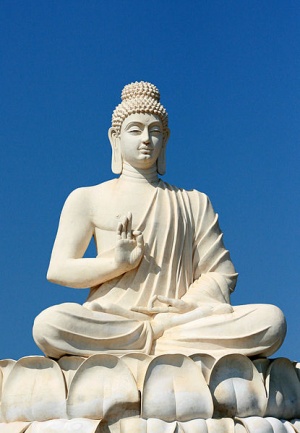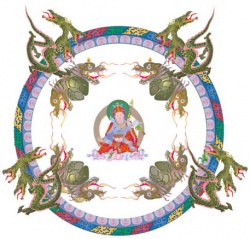Mettā
- See also :
- See also :
Mettā (Pali: मेत्ता in Devanagari) or maitrī (Sanskrit: मैत्री) is loving-kindness, friendliness,benevolence, amity, friendship, good will, kindness, close mental union (on same mental wavelength), and active interest in others. It is one of the ten pāramīs of the Theravāda school of Buddhism, and the first of the four sublime states (Brahmavihāras). This is love without clinging (upādāna).
The cultivation of loving-kindness (mettā bhāvanā) is a popular form of meditation in Buddhism. In the Theravadin Buddhist tradition, this practice begins with the meditator cultivating loving-kindness towards themselves, then one's loved ones, friends, teachers, strangers, enemies, and finally towards all sentient beings. In the Tibetan Buddhist tradition, this practice is associated with tonglen (cf.), whereby one breathes out ("sends") happiness and breathes in ("receives") suffering. Tibetan Buddhists also practice contemplation of the Brahmavihāras, also called the four immeasurables, which is sometimes called 'compassion meditation'
"Compassion meditation" is a contemporary scientific field that demonstrates the efficacy of metta and related meditative practices.
Basic methods
Mettā meditation is regularly recommended to the Buddha's followers in the 2,500-year-old Pali canon. The canon generally advises radiating metta in each of the six directions, to whatever beings there may be. A different set of practical instructions, still widely used today, is found in the 5th CE Visuddhimagga. In addition, variations on this traditional practice have been popularized by contemporary teachers and applied in modern research settings.
Visuddhimagga instructions
Contemporary instruction for the cultivation of loving-kindness – such as is found in the works of Sharon Salzberg, the Triratna Buddhist Community's Kamalashila, and Matthieu Ricard – is often based in part on a method found in Buddhaghosa's 5th c. CE Pāli exegetical text, the Path to Purification (Pali:Visuddhimagga), Chapter IX. This traditional approach is best known for identifying successive stages of meditation during which one progressively cultivates loving-kindness towards:
- oneself
- a good friend
- a "neutral" person
- a difficult person
- all four of the above equally
- and then gradually the entire universe
Contemporary trainings
Mettā signifies friendship and non-violence, "a strong wish for the happiness of others" and also less obvious or direct qualities such as showing patience, receptivity, and appreciation. Loving-kindness is a very specific feeling – a caring for the well-being of another living being, independent of approving or disapproving of them, or expecting anything in return. Practice includes reciting specific words and phrases in order to evoke a "boundless warm-hearted feeling," or visualizing suffering and wishing well for those beings. Non-referential compassion, also known as "pure compassion", involves simply experiencing the feeling of caring for another sentient being. One special technique recommended by Matthieu Ricard is to, "imagine," the state of another. Richard J. Davidson has shown metta to induce changes in the tempoparietal lobe. Loving-kindness is the application of love to suffering. Metta is applied to all beings and, as a consequence, one experiences another of the sublime states: joy (mudita), which is true happiness in another being's happiness.
All sentient beings desire happiness and do not desire misery. Think deeply about how, in this beginning-less cycle of existence, there is not one sentient being who has not been my friend and relative hundreds of times. Therefore, since there is no ground for being attached to some and hating others, I shall develop a mind of equanimity toward all sentient beings. Begin the meditation on equanimity by thinking of a neutral person, and then consider people who are friends and foes.
Benefits
The benefits of metta practice are both extolled by ancient texts and increasingly identified by contemporary research.
Traditional accounts
The most ancient extant Buddhist collection of texts, the Pali Canon, identifies a number of benefits from the practicing of metta meditation, including:
- One sleeps easily, wakes easily, dreams no evil dreams. One is dear to human beings, dear to non-human beings. The devas protect one. Neither fire, poison, nor weapons can touch one. One's mind gains concentration quickly. One's complexion is bright. One dies unconfused and – if penetrating no higher – is headed for the Brahma worlds.
The Canon also upholds fully ripened metta development as a foremost antidote to ill will:
- “No other thing do I know, O monks, on account of which unarisen ill will does not arise and arisen ill will is abandoned so much as on account of this: the liberation of the heart by loving-kindness. For one who attends properly to the liberation of the heart by loving-kindness, unarisen ill will does not arise and arisen ill will is abandoned.”
Monks, whatever grounds there are for making merit productive of a future birth, all these do not equal a sixteenth part of the liberation of mind by loving-kindness. The liberation of mind by loving-kindness surpasses them and shines forth, bright and brilliant.
Buddhists believe that those who cultivate loving-kindness will be at ease because they will see no need to harbour ill will or hostility. Buddhist teachers may even recommend meditation on loving-kindness as an antidote to insomnia and nightmares. It is generally felt that those around a person full of loving-kindness will feel more comfortable and happy too. Cultivating loving-kindness is thought to contribute to a world of love, peace and happiness.
Meditation on loving-kindness is considered a good way to calm down a distraught mind and an antidote to anger. Someone who has cultivated loving-kindness will not be easily angered and can quickly subdue anger that arises, being more caring, more loving, and more likely to love unconditionally.
"Compassion meditation" research
A few recent psychological studies suggest that loving-kindness meditation may impact health and well-being. One study done at Stanford University suggests that a short 7 minute practice of loving-kindness meditation can increase social connectedness. Loving-kindness meditation has also been shown to reduce pain and anger in people with chronic lower back pain. Researcher Barbara Fredrickson at the University of North Carolina at Chapel Hill found that loving-kindness meditation can help boost positive emotions and well-being in life, fostering the personal resources that come from experiencing positive emotion. More research is needed to see whether loving-kindness meditation is appropriate for all populations, whether it works similarly for everyone, and to understand how much practice is needed for the benefits of the practice to manifest.
An EEG study by Richard J. Davidson of people who meditate in metta, with a minimum of 10,000 hours practice, showed substantial differences in the magnitude of gamma waves as well as gamma synchronization, particularly during meditative sessions, and directly afterwards. During baseline states, where the subject was not engaged in the practice of metta, there was a signature brain wave pattern that distinguishes the metta practitioners, lay people as well as monks, from people, at baseline, who have not extensively practiced compassion meditation. This study also showed, during meditation, an increase in the activity of brain areas such as the temporoparietal junction, insula, and amygdala and increase the subject's ability to see things from another's perspective, and actually change the area of the brain that is involved with the autonomic system so that the meditator's heartbeat increases. These studies show that the amygdala is modulated during compassion mediation. Compassion meditation has been shown to lower the participants reaction to inflammation and distress, both of which are associated with, "major depression, heart disease and diabetes," in response to stressors, a change that was dependent on the amount of time spent practicing, with practitioners who spent more time meditating having corresponding more significant changes in their brains.
Historical presentations
In the Pāli Canon, statements regarding the use of loving-kindness (metta) traditionally employ one or more of the following devices, often using a stock formula:
- mental purification
- a verse for wishing others well
- pervading all directions and all beings with loving-kindness.
The well-known Kakacupama Sutta and Karaniya Metta Sutta use striking metaphors to give these traditional devices vitality. Other canonical materials, such as in the Paṭisambhidāmagga, elaborate on these basic devices in a manner that is perpetuated by the later traditional commentaries. Other canonical sources, such as the Abhidhamma, underline the key role of loving-kindness in the development of wholesome karma.
Basic intention and verse
|
May these beings be |
In the Sutta To Cunda the Silversmith (Cunda Kammaraputta Sutta, AN 10.176), the Buddha explains that mental or intentional purity (manasā soceyyaṃ) is threefold: non-greed, non-ill-will and non-delusion. Regarding the manifestation of non-ill-will the discourse describes a virtuous person in the following manner (in English and Pāli):
|
He or she bears no ill will and is not corrupt in the resolves of his heart. |
Avyāpannacitto hoti appaduṭṭhamanasaṃkappo, |
This basic statement of intention and verse can also be found in several other canonical discourses.
Basic radiating formula
In over a dozen discourses, the following description (in English and Pāli) is provided for radiating loving-kindness in six directions:
|
One abides, having suffused with a mind of loving-kindness |
So mettāsahagatena cetasā |
In the canon, this basic formula is expanded upon in a variety of ways. For instance, a couple of discourses provide the following description of "the path to the company of Brahmā" (brahmānaṃ sahavyatāya maggo) along with a memorable metaphor:
- "What ... is the path to the company of Brahmā? Here a bhikkhu abides pervading one quarter with a mind imbued with loving-kindness, likewise the second, likewise the third, likewise the fourth; so above, below, around, and everywhere, and to all as to himself, he abides pervading the all-encompassing world with a mind imbued with loving-kindness, abundant, exalted, immeasurable, without hostility, and without ill will. When the deliverance of mind by loving-kindness is developed in this way, no limiting action remains there, none persists there.
- "Just as a vigorous trumpeter could make himself (or herself) heard without difficulty in the four quarters, so too, when the deliverance of mind by loving-kindness is developed in this way, no limiting action remains there, none persists there. This is the path to the company of Brahmā."
Kakacupama Sutta (MN 21)
Incorporating facets of the above textual methods in a series of increasingly vivid similes, the Parable of the Saw Discourse (Kakacupama Sutta, MN 21) provides the following culminating scenario:
- "Monks, even if bandits were to savagely sever you, limb by limb, with a double-handled saw, even then, whoever of you harbors ill will at heart would not be upholding my Teaching. Monks, even in such a situation you should train yourselves thus: 'Neither shall (ones') minds be affected by this, nor for this matter shall (one shall) give vent to evil words, but we shall remain full of concern and pity, with a mind of love, and we shall not give in to hatred. On the contrary, (one) shall live projecting thoughts of universal love to those very persons, making them as well as the whole world the object of our thoughts of universal love – thoughts that have grown great, exalted and measureless. (One) shall dwell radiating these thoughts which are void of hostility and ill will.' It is in this way, monks, that (one) should train (one)self."
Karaniya Metta Sutta (Sn 1.8)
- See also:Metta Sutta
|
In gladness and in safety, |
|
Even as a mother |
The Karaniya Metta Sutta (Sn 1.8) combines both the interpersonal and radiant aspects of canonical expressions of loving-kindness.
|
This is what should be done |
Karaṇīyam- |
|
Whatever living beings there may be; |
Ye keci pāṇa bhūtatthi |
|
The seen and the unseen, |
Diṭṭhā vā yeva addiṭṭhā |
|
Let none deceive another, |
Na paro paraṃ nikubbetha |
|
Even as a mother protects with her life |
Mātā yathā niyaṃ puttaṃ āyusā |
|
Radiating kindness over the entire world |
Mettaṃ ca sabbalokasmiṃ |
|
Whether standing or walking, seated or lying down |
Tiṭṭhaṃ caraṃ nisinno vā sayāno |
According to the Pāli commentaries, the Buddha originally gave this instruction (of loving-kindness meditation) to monks who were being harassed by the tree spirits of a forest in which the monks were trying to meditate. After doing this meditation in the forest it is said that the spirits were so affected by the power of loving-kindness that they allowed the monks to stay in the forest for the duration of the rainy season.
Patisambhidamagga Mettakatha (Ps. 2.4)
|
May all beings be free from |
In the Khuddaka Nikāya's Paṭisambhidāmagga, traditionally ascribed to Ven. Sariputta, is a section entitled Mettākathā (Ps. 2.4, "Instruction on Loving-Kindness"). In this instruction, a general formula (below, in English and Pāli), essentially identical to the aforementioned Cunda Kammaraputta Sutta verse (especially evident in the Pāli), is provided for radiating loving-kindness:
|
"May all beings be |
Sabbe sattā |
In addition, this instruction categorizes twenty-two ways in which "the mind-deliverance of lovingkindness" (mettācetovimutti) can be radiated as follows:
- five ways of "unspecified pervasion" (anodhiso pharaṇā):
- all beings (sabbe sattā )
- all breathing things (sabbe pāṇā bhāvapariyāpannā)
- all creatures (sabbe bhūtā bhāvapariyāpannā)
- all persons (sabbe puggalā bhāvapariyāpannā)
- all with a personality (sabbe attabhāvapariyāpannā)
- seven ways of "specified pervasion" (anodhiso pharaṇā):
- all women (sabbā itthiyo)
- all men (sabbe purisā)
- all Noble Ones (sabbe ariyā)
- all non-Noble Ones (sabbe anariyā)
- all deities (sabbe devā)
- all humans (sabbe manussā)
- all born in lower realms (sabbe vinipātikā)
- ten ways of "directional pervasion" (disā-pharaṇā):
- of the eastern direction (puratthimāya disāya)
- of the western direction (pacchimāya disāya)
- of the northern direction (uttarā disāya)
- of the southern direction (dakkhīṇāya disāya)
- of the eastern intermediate direction (puratthimāya anudisāya)
- of the western intermediate direction (pacchimāya anudisāya)
- of the northern intermediate direction (uttarā anudisāya)
- of the southern intermediate direction (dakkhīṇāya anudisāya)
- of the downward direction (heṭṭhimāya disāya)
- of the upward direction (uparimāya disāya).
Moreover, the directional pervasions can then be applied to each of the unspecific and specific pervasions. For instance, after radiating loving-kindness to all beings in the east (Sabbe puratthimāya disāya sattā ...), one radiates it to all beings in the west and then north and then south, etc.; then, one radiates it to all breathing things in this fashion (Sabbe puratthimāya disāya pāṇā ...), then all creatures, persons, and so forth until such is extended for all those born in the lower realms.
Abhidhammic descriptor (Dhs. 189)
|
What are the three |
In the Abhidhamma's Dhammasaṅgaṇi, the causes of "good" or "wholesome" (kusala) and "bad" or "unwholesome" (akusala) karmic states (dhammā) are described (Dhs. 188ff.). The three causes of wholesome karma are stated to be the non-greed, non-hate and non-delusion (alobho adoso amoho; cf. kleśā). Non-hate is then defined in the following manner:
|
The absence of hate, hating, hatred; love, loving, loving disposition; tender care, forbearance, considerateness; seeking the general good, compassion; the absence of malice, of malignity; that absence of hate which is the root of good (karma). |
Yo adoso adussanā adussitattaṃ metti mettāyanā mettāyitattaṃ anuddayā anuddayanā anuddayitattaṃ hitesitā anukampā avyāpādo avyāpajjho adoso kusalamūlaṃ, ayaṃ vuccati adoso. |















